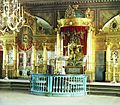Iconostasis facts for kids
Imagine a beautiful wall covered with religious paintings called icons! That's what an iconostasis is in Eastern Orthodox Churches. This special wall stands between the main part of the church where people gather and a sacred area called the sanctuary, which is usually just for priests. It's like a visual storybook that helps people connect with their faith.
Contents
What is an Iconostasis?
An iconostasis is a tall screen or wall found in Eastern Orthodox churches. It is covered with many icons, which are religious images of Jesus Christ, the Theotokos (Mary, the mother of Jesus), saints, and important events from the Bible. This wall separates the area where the public sits from the altar area, which is considered the holiest part of the church.
Why is it There?
The iconostasis has a very important job. It helps to show the connection between heaven and earth. The icons on the wall represent saints and holy figures who are believed to be in heaven, looking down on the people in the church. It also creates a sense of mystery and respect for the sacred rituals happening in the sanctuary.
Parts of an Iconostasis
An iconostasis usually has several rows of icons, each with a special meaning:
- The Royal Doors: These are the main doors in the center of the iconostasis. Only priests and deacons can go through them during church services.
- Deacon's Doors: There are smaller doors on either side of the Royal Doors. Deacons and altar servers use these.
- The Local Row: This is the bottom row, closest to the people. It usually has icons of Jesus Christ and the Theotokos on either side of the Royal Doors. It also often includes an icon of the saint or event that the church is named after.
- The Deesis Row: Above the local row, this row shows Jesus Christ in the center, with the Theotokos and John the Baptist praying to him. Other saints and angels might also be in this row.
- The Feasts Row: This row shows icons of the twelve most important holidays (feasts) in the Orthodox Church.
- The Prophets Row: This row, usually higher up, features icons of Old Testament Prophets who predicted the coming of Jesus.
- The Ancestors Row: Sometimes, there's a very top row with icons of the ancestors of Jesus, like Adam and Eve.
History of the Iconostasis
The idea of separating the altar from the public part of the church has been around for a very long time. In early Christian churches, there was often a low barrier or curtain. Over many centuries, this barrier grew taller and more elaborate, eventually becoming the tall, icon-covered wall we see today. By the 15th century, the iconostasis had become a central feature of Eastern Orthodox churches.
Images for kids
-
Five-panel Deesis row (center), Iconostasis in the Cathedral of the Annunciation in Moscow Kremlin by Theophanes the Greek, 1405
-
Mid-17th-century iconostasis at Ipatiev Monastery. To either side of the Holy Doors are Christ Pantokrator and the Theotokos; above them, the Great Feasts; above them, the Deesis; above that Prophets to either side of Our Lady of the Sign; above them the Apostles to either side of the Holy Trinity.
-
Iconostasis at Holy Trinity Cathedral in Chicago, Illinois
-
Fedorov's Deesis, recently added to the retroquire screen at Winchester Cathedral, England. The differently situated rood screens of Western medieval churches often achieved an effect comparable to the iconostasis.
See also
 In Spanish: Iconostasio para niños
In Spanish: Iconostasio para niños






